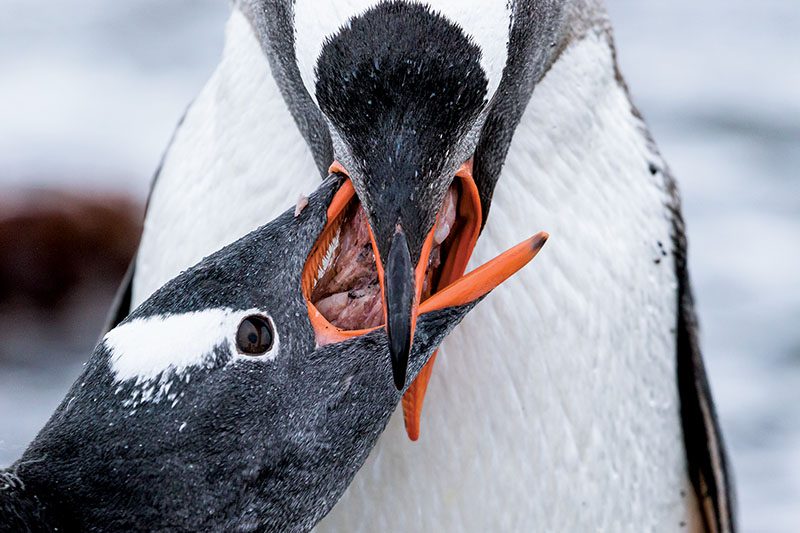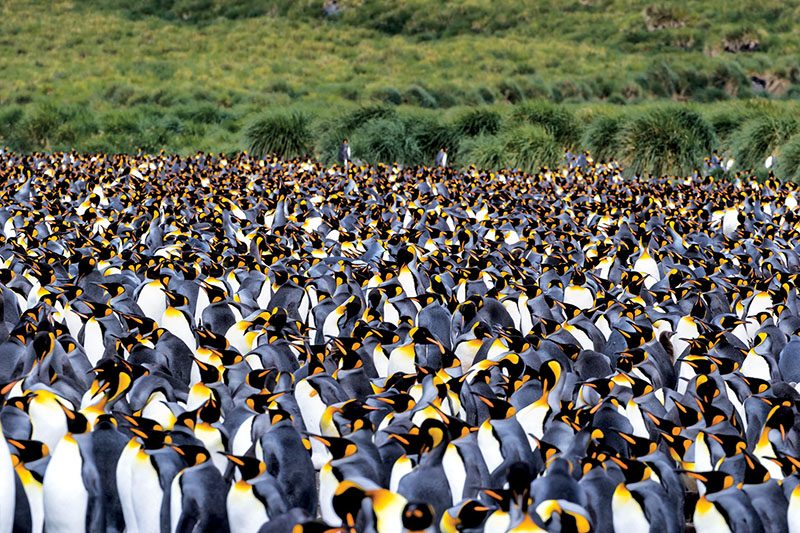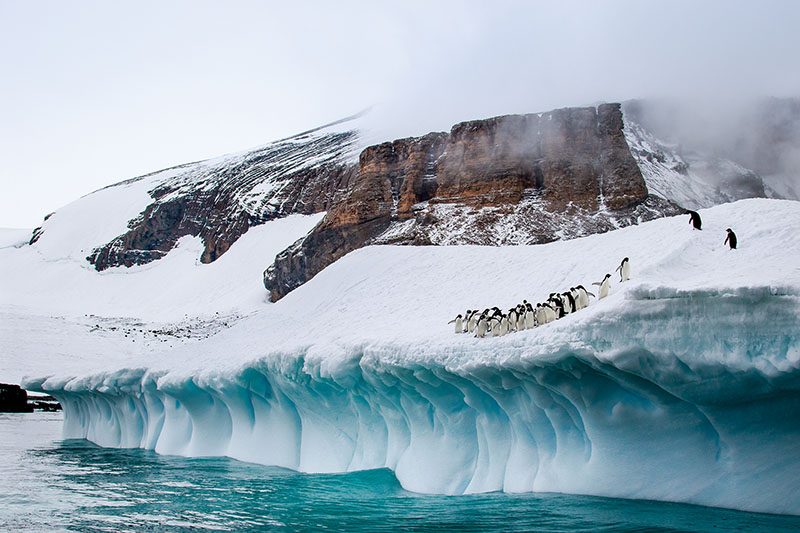Penguins are rugged survivors.
One of the greatest symbols of wildlife in the animal kingdom, penguins endear themselves with their comical antics and wow us by thriving in unbelievably hostile environments. They are polar ambassadors, a signifier of climate change, and an example of persistence in the face of extremes.
Working as a naturalist and a guide in Antarctica and the sub-Antarctic islands, I have been privileged to spend a great deal of time with these birds during their breeding season. While their amusing waddling, rock thieving, and squabbling still delight me, I have become more impressed with these rugged survivors the more I understand them.
The 18 living species of penguins range from 15 inches to more than 3 feet tall and weigh from 2 to almost 90 pounds. Every species exhibits flippers for wings, webbed feet, and a sharp bill.
Most penguins live in the Southern Hemisphere’s far reaches, populating sub-Antarctic islands and the continent. The Galápagos penguin is the only species in the Northern Hemisphere and lives only barely across the equator. Magellanic and Humboldt penguins thrive in South American waters. These more tropical varieties share many adaptations with their coldwater relatives but have some modifications to deal with the warmer temperatures. Specifically, warmwater penguins have more exposed skin on their face and head to better vent excess heat.
All species have warm feathers that trap air close to the skin to preserve body heat, similar to a drysuit. While watching them dive underwater, you will occasionally notice bubbles squeezing from their plumage as the pressure increases. Recent research indicates penguins have about 23 contour feathers per square inch with about four plumules, or insulating down feathers, for each contour feather.
As with divers, the perfect suit requires maintenance. Penguins often roll in the shallows, rubbing themselves with their flippers to clean any dirt or excrement from their plumage. That’s not always an easy task. Unlike a flying bird’s feathers, which are often in tracks or rows for aerodynamics, a penguin’s feathers grow in staggered like shingles — a better arrangement to keep out water. An oil gland at the base of their tail provides additional waterproofing by coating the outside feather layer. Each penguin feather has an individual muscle to control its position. This control allows the birds to independently shake, vent, shiver, and shift each feather.
Penguin coloration, which is abundant in the marine world and appears in animals from birds to sharks to mammals, is an excellent evolutionary tactic. These animals appear white and thus somewhat camouflage into the brighter overhead water when seen from below. From above, the black blends into the dark below. With penguins, however, there is a secondary function: A dark and a bright side allows them to either reflect or absorb heat from the sun.


Once a year penguins must surrender the comfort of their plumage and undergo a catastrophic molt, whereby they lose all their feathers at once. This energy-intensive process renders the penguins tired, uncomfortable, and landbound without their waterproof and insulating feathers until the new ones grow in. For these two to four weeks, the birds are at their most vulnerable and can’t enter the water to feed.
Their bills are another precious tool. With no hands, paws, or claws, a penguin must rely on its face to do their most important work: applying the waterproofing oil to their feathers, catching and devouring their prey, defending their nest from predators or bothersome neighbors, and making courtship displays. The penguin’s bill is a remarkably agile appendage capable of great feats of strength or the most delicate processes. Rear-facing keratin spikes line the palate and tongue; these papillae ensure their prey can only move in one direction — down the esophagus.
Penguins eat a variety of prey, but most warmwater species eat small schooling fish. Just like many seabirds, their guano is white and full of scales from their unfortunate quarry. The colder species leave a pink stain around their colonies. It doesn’t come from crab, as early explorers presumed, but krill.
One of the most abundant open-water animals, these decapods are the base of the Southern Ocean’s food web. Krill feed on plankton, which most often grows on the underside of sea ice, making krill the marine system’s primary grazers. There is scarcely an Antarctic animal that does not owe most of its food energy to krill. While diatomaceous plankton is the base of Antarctica’s trophic system, krill convert it into essential fats and proteins.
While continued krill fishing has contributed to the depletion of the penguins’ food source, penguins themselves are squarely in the middle of the food chain for their natural predators. Leopard seals catch the young birds and thrash their victims on the surface with such strength that the skin and feathers detach from the musculature. Killer whales will pursue and harass penguins, often to death, while training their young.
Penguins face a relentless threat from large gulls and skuas, which are predatory gull-like birds with serious cunning. These fellow avians often steal penguins’ eggs and even chicks. Skuas have been known to target a brooding adult and work in a team to draw it off the nest. By pulling on tail feathers or dive-bombing, one skua overwhelms the parent penguin enough to make it stray from its nest while another skua swoops in to pluck a helpless chick.
Surviving this barrage of threats is no small task. Once out to sea, however, the danger lessens, and the chore of feeding begins. When penguins catch krill, fish, or other marine animals, they also get a belly full of salt water. They rely on an adaptation they share with many other sea birds to rid themselves of excess salt. Desalination glands inside their heads near the eye orbital concentrate the salt in their blood to form a hypersaline solution that they excrete out of their nostrils.
Most visitors experience penguins on shore, where they spend only a fraction of their lives. They return to land solely for breeding and chick rearing. Reproduction is a serious matter in the penguin world. They choose mates for different reasons depending on the species. It might be the sound of their call (a deeper sound indicates a thicker neck with more fat reserves), the pebbles they offer, or the nesting area they stake out. They prioritize previous partners, but it is incorrect to say penguins are monogamous. If two birds have successfully bred together in the past, they are much more likely to pair again. The adults will seek new partners if a former one does not return to the breeding ground or the chicks fail to fledge.

Males generally arrive at the breeding grounds first and stake out the exact location where they were successful last year. While this spot is most likely snow-covered early in the year, the penguins wait patiently. They darken the snow with guano while waiting, which slightly increases the snow’s melting speed.
The females return a little later, having accumulated extra fat to support the caloric expense of laying eggs. If the pair is lucky to find each other for another season, they renew their bonds with courtship displays and calling. Copulation soon occurs, with the male standing clumsily on the prone female for some time before accomplishing the act. They get plenty of opportunities, as pairs mate quite frequently during this time. The females produce the precious eggs shortly afterward, and a new penguin chick or two emerges within a few weeks (except with emperor penguins, which overwinter their single eggs).
A dangerous and fragile life awaits the new bird, but the ones that make it past the skuas and gulls, receive enough food from their attentive parents, and complete the uncomfortable adolescence of the first molting will be fine young penguins. Ready to face the leopard seals who wait in the nearby shallows or the persistent pursuit of killer whales, young penguins amass at the water’s edge, waiting for some unknown signal before all rushing in at once.
Then they return to the sea, the habitat for which they have truly adapted. You would never see penguins out of the water were it not for the need to lay eggs and rear chicks on dry land. They may seem silly and encumbered when walking around a beach with such difficulty, but they are an example of perfect adaptation to a harsh and unforgiving landscape.
Having surrendered all claim to the sky and become a bird of the sea, they have shaped and evolved themselves to that end. Humans may giggle at or idolize them, but the penguin is a champion of extremes and worthy of respect.
© Alert Diver — Q1 2023